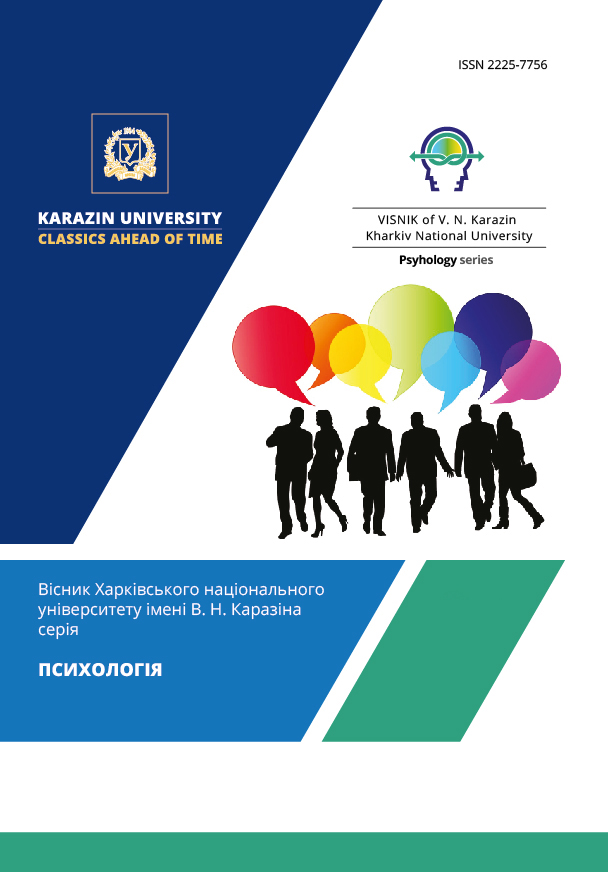Взаємопов’язанність особливостей сприйняття часу та імпульсивності в українських студентів
Анотація
Визначення взаємозв’язку між особливостями індивідуального сприйняття часу і особистісної рисою імпульсивності є проблемою, якій присвячено це дослідження. Метою дослідження є аналіз зв’язків між різними складовими імпульсивності як риси особистості та особливостями індивідуальної хвилини (ІХ) з урахуванням віку і статі на вибірці українських університетських студентів (62 учасники віком 17-22, з них 11 чоловіків). Для оцінки особливостей сприйняття часу використовувався метод ІХ за Ф. Халбергом. Як характеристики ІХ використовувалися середнє і стандартне відхилення за трьома послідовними вимірюваннями ІХ і середня помилка суб›єктивного часу щодо об›єктивного у відсотках. Імпульсивність вимірювалася за допомогою тесту Шкала імпульсивної поведінки (UPPS-P Impulsive Behavior Scale) в українській адаптації, яка виявляє 5 показників імпульсивності: негативну нагальність, позитивну нагальність, брак далекоглядності, брак наполегливості, пошук вражень. В українських студентів показники імпульсивності відповідають середнім нормам французької вибірки. Середня ІХ становить 61,3 секунди і знаходиться в діапазоні 36-88 секунд, стандартне відхилення 3-х вимірювань становить 8 секунд, середня помилка суб’єктивного часу щодо об’єктивного склала 9%. Був виявлений зворотний зв’язок середньої тривалості ІХ і показника імпульсивності «позитивна нагальність». Також виявлений прямий зв’язок варіабельності ІХ, середньої помилки ІХ у відсотках і показника імпульсивності «брак наполегливості». Відсутні істотні відмінності в середній тривалості ІХ між чоловіками і жінками. У той же час жінки мають достовірно більш високу варіабельність в оцінці часу – стандартне відхилення ІХ у них значно більше, ніж у чоло віків. За особливостями імпульсивності жінки мають значимо вищий показник позитивної нагальнос ті, ніж чоловіки. Вікові відмінності в особливостях сприйняття часу і імпульсивності не встановлені.
Завантаження
Посилання
Кузнецов О.Н., Алехин А.Н., Самохина Т.В., Моисеева Н.И. Методические подходы к исследованию чувства времени у человека // Вопросы психологии. – 1985. – №4. – С. 140–144.
Портнова Г.В. Компьютерная методика исследования индивидуальных особенностей оценки и отмеривания временных интервалов // Вестн. Моск. ун-та. Сер. 14 – Психология. – 2007. – №2. – С. 114–122.
Цуканов Б.И. Время в психике человека. – Одесса: Астропринт, 2007. – 220 с.
Billieux, J. et al. (2012). Validation of a short French version of the UPPS-P Impulsive Behavior Scale. Comprehensive Psychiatry, 53, 609-615. doi: 10.1016/j.comppsych.2011.09.001.
Buchwald, C., & Blatt, S. J. (1974). Personality and the experience of time. Journal of Consulting and Clinical Psychology, 42(5), 639–644. doi:10.1037/h0036939
Daugherty, J. R. (2011). Time perception’s effect on individual differences and behavior: the mediating role of impulsivity on the relationship between time perception and intertemporal health behaviors (Doctoral dissertation). Retrieved from https://krex.k-state.edu/dspace/handle/2097/9164
Dreher, J. C, Meyer-Lindenberg, A., Kohn, P., Berman, K. F. (2008). Age-related changes in midbrain dopaminergic regulation of the human reward system. Proceedings of the National Academy of Sciences of the United States of America. 105(39), 15106–15111. doi:10.1073/pnas.0802127105.
Faulkner, K. K., & Gutsch, U. G. (1986). Determining rate of subjective time according to subject sex, weight, and locus of control orientation. Eating Disorders, 5(4), 777-781. doi.org/10.1002/1098-108X(198605)5:4<777::AID-EAT2260050417>3.0.CO;2-M
Halberg, F. (1969). Chronobiology. Annual Review of Physiology 31, 675–725. doi: 10.1146/annurev.ph.31.030169.003331
Halberg, F. et al. (2006). Diversity in time complements diversity in space: chronobiology and chronomics complement mendel’s genetics and purkinje’s self-experimentation. Scripta Medica (BRNO), 79 (3), 135-140.
Jokic, T., Zakay, D., & Wittmann, M. (2018). Individual differences in self-rated impulsivity modulate the estimation of time in a real waiting situation. Timing & Time Perception, 6, 71–89. doi.org/10.1163/22134468-00002101
Kent, L., Van Doorn, G., & Klein, B. (2019). Systema Temporis: A time-based dimensional framework for consciousness and cognition. Consciousness and Cognition, 73, 102766. doi:10.1016/j.concog.2019.102766
Kornbrot, D. E., Msetfi R. M., Grimwood, M. J. (2013). Time perception and depressive realism: judgment type, psychophysical functions and bias. PLOS ONE, 8(8), e71585. doi:10.1371/journal.pone.0071585.
Lehockey, K. A., Winters, A. R., Nicoletta, A. J., Zurlinden, T. E., & Everhart, D. E. (2018). The effects of emotional states and traits on time perception. Brain Informatics, 5(2): 9. doi: 10.1186/s40708-018-0087-9
Lynam, D. R., Smith, G. T., Whiteside, S. P., & Cyders, M. A. (2006). The UPPS-P: Assessing fie personality pathways to impulsive behavior. Technical report. West Lafayette, IN: Purdue University.
Mccown, (1986). An experimental investigation of some hypothesized behaviors of college student procrastinators (Master’s dissertation). Retrieved from https://ecommons.luc.edu/cgi/viewcontent.cgi?referer=&httpsredir=1&article=4495&context=luc_theses
Moreira, D., Pinto, M., Almeida, F., & Barbosa, F. (2016). Time perception defiits in impulsivity disorders: A systematic review. Aggression and Violent Behavior, 27, 87–92. doi:10.1016/j.avb.2016.03.008
Mueller, A. K., Berger, J., Tucha, O., & Falter, C. M. (2014). Selective Impairment of Timing Functions in Non-Clinical Impulsiveness. Timing & Time Perception, 2(1), 20-34. doi.org/10.1163/22134468-00002008
Plourde, M., Gamache, P., Laflmme, V., & Grondin, S. (2017). Using Time-Processing Skills to Predict Reading Abilities in Elementary School Children. Timing & Time Perception, 15(1), 35-60. doi. org/10.1163/22134468-00002079
Prenger, J. H. (2005). Individual differences in timing sensitivity: implications for interval timing models (Doctoral dissertation). Retrieved from http://knowledgecommons.lakeheadu.ca:7070/handle/2453/3295
Rammsayer, T. H. (1997). On the relationship between personality and time estimation. Personality and Individual Differences, 23(5), 739-744. doi.org/10.1016/S0191-8869(97)00117-7
Rammsayer, T. H., & Rammstedt, B. (2000). Sex-related differences in time estimation: the role of personality. Personality and Individual Differences, 29(2), 301–312. doi:10.1016/s0191-8869(99)00194-4
Warner, D. J., & Block, R. A. (1984). Type A behavior and temporal judgment. Bulletin of the Psychonomic Society, 22(3), 163–166. doi.org/10.3758/BF03333793
Wittmann, M., & Paulus, M. P. (2008). Decision making, impulsivity and time perception. Trends in cognitive Sciences, 12, 7-12. doi: 10.1016/j.tics.2007.10.004
Wittmann, M., Jokic, T., & Pfeifer, E. (2019). Modulations in the Experience of Duration. In: Arstila V., Bardon A., Power S., Vatakis A. (eds) The Illusions of Time. Palgrave Macmillan, Cham. doi.org/10.1007/978-3-030-22048-8_9




